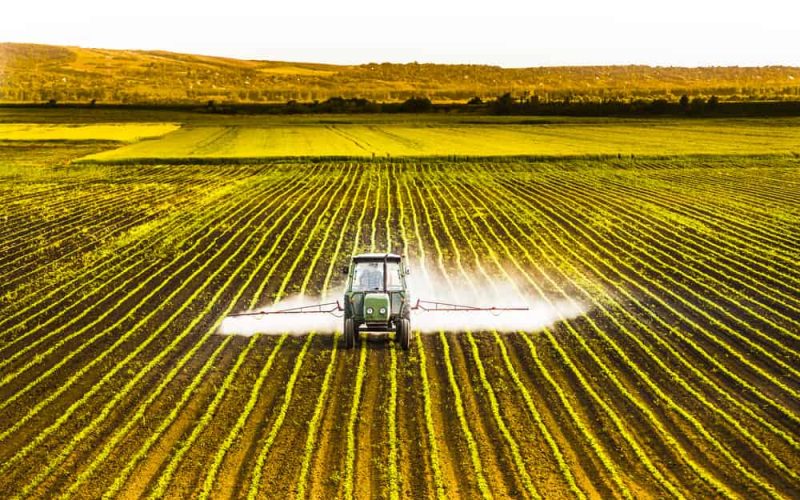Weed is any plant growing where they are not supposed to. They are undesirable plants growing in a human-controlled setting.
They grow more quickly, their seeds are generally easy to disperse and are typically considered to be a nuisance by farmers.
They usually become the dominant species when introduced into the environment by agents such as wind, animals, water, or even humans.
They compete with local plants or water, space, and sunlight, and if left uncontrolled, they kill local plants. To control the spread of weeds, agriculturists employ the use of herbicides.
Herbicides are chemical agents used to kill or inhibit the growth of unwanted plant species, such as invasive species or agricultural weeds.
Since weeds compete with crop plants for sunlight, nutrients, water, and space, they may decrease the productivity and yield of crop plants, hence resulting in economic damage.
Plants may also be judged to be undesirable if they interfere with a desired aesthetic effect, such as weed on lawns.
Compared to mechanical weed control – such as pulling weed by hands or the use of a cutting device- chemical herbicide control saves time and cost of labor.
Most herbicides are not considered toxic to animals and humans but can cause substantial damage to weeds and the insects that depend on them.
Herbicides are usually synthetic mimics of natural plant hormones that inhibit the growth of target plants. Plant hormones that inhibit growth are ethylene and abscisic acid.
Some plants, such as the black walnut and some species of Eucalyptus, produce their own natural herbicides, a phenomenon known as allelopathy.
History of Herbicides
Traditionally, the control of weed through the use of chemicals has been practiced for a very long time. Oils, industrial by-products, and sea salts were often employed in time past.
The selective control of weeds in fields of cereal crops in France was discovered in the late 19th century, and this practice quickly spread throughout Europe.
Nitrates and sulfates of iron and copper were employed, and the use of sulphuric acid made weed control even more efficient.
Also, sodium arsenite was made popular both as a spray and a chemical used to sterilize the soil. In the equatorial regions where crops like rubber and sugarcane were grown, more toxic materials were used in the control of weeds.
This often resulted in the poisoning of animals and, sometimes, humans. However, significant progress was made in the production of herbicides from the late 1940s.
In 1945 at the height of World War II, 2,4-D (2,4-dichlorophenoxyacetic acid), IPC (isopropyl-N-phenylcarbamate), and 2,4,5-T (2,4,5-trichlorophenoxyacetic acid) were introduced. 2,4-D and 2,5,D-T are selective herbicides used to control broad leaves, while IPC is a selective herbicide used to control grass weeds.
Since then, great strides have been made in the development of herbicides and the control of weeds.
Certain plants known as herbicide-resistant crops (HRCs) have been created with the use of genetic engineering. These plants have been genetically engineered to resist chemical herbicides such as glyphosate.
Thus, enabling the effective control of weeds since only plants that can resist herbicides can survive. The herbicide-resistant plants survive when treated with their corresponding herbicides.
Such crops have proven to be especially valuable for farming that does not involve tilling, as this would prevent soil erosion caused by the tillage of the soil.
However, rather than decrease the application of herbicides, the plants encourage the increased utilization of herbicides in the soil, making it more saturated.
This poses an environmental hazard, especially to microorganisms in the soil that are necessary for plant growth.
How Herbicides Work
Generally, herbicides are classified according to their site of action. Herbicides belonging to the same site of action class will produce similar reactions on plants that are susceptible to it.
Also, classifying herbicides, based on their mode of action, uses factors like protein, enzyme, and biochemistry of plant upon application. Listed below are the mode of actions found in some herbicides;
Triazine Herbicides
These types of herbicides are commonly used in the cultivation of corn. They are also used to sterilize the soil.
Triazine herbicides do not usually persist on the surface of the soil, but they are very mobile and can contaminate groundwater. Examples of this class of herbicides include;
- Simazine (2-chloro-4,6-bis-(ethyl-amino)-s-triazine);
- Hexazinone (3-Cyclohexyl-6-(dimethyl-amino)-1-methyl-1,3,5-triazine-2,4(1H,3H)-dione)
- Atrazine (2-Chloro-4-(ethylamino)-6-(isopropylamino)s-triazine)
- Metribuzin (4-Amino-6-tert-butyl-3-(methylthio)-as-triazin-5(4H)-one);
- Cynazine (2-(4-Chloro-6-ethylamino -5-triazin-2-ylamino)-2-methylpropionitrile)
Chlorophenoxy acid Herbicides
These work by mimicking the auxins present in the plant. Natural auxins promote the elongation of stems and inhibit the growth of lateral buds. This mimicry causes toxicity to the plant and leads to the growth of abnormalities.
Chrolorphenoxy acid herbicides are selective for broad-leaved dicotyledonous plants. Monocots can tolerate them at the same spray rate used. Examples include:
- 2,4,5-T (2,4,5-Trichlorophenoxyacetic acid)
- 2,4-D (2,4-Dichlorophenoxyacetic acid)
- Silvex [2-(2,4,5-Trichlorophenoxy)-propionic acid].
- MCPA (2-Methyl-4-chlorophenoxyacetic acid)
Organic phosphorus Herbicides
The most common organic phosphorus herbicide is glyphosphate (N-phosphonomethyl-glycine). Glyphosphate has a wide range of uses in agriculture and forest management.
For glyphosphate to work, it is taken up into roots and rhizomes, where it interferes with certain amino acid synthesis. Due to glyphosphate being potentially toxic to many crop species.
Its effective utilization requires the understanding of changes in seasons in the vulnerability of both weed and crop species to herbicides.
Glyphosphate, unlike triazine herbicides, does not move in soils. It is moderately persistent and does not affect animals very much.
Environmental Impact of Herbicides
Herbicides, when not used properly, can cause damage to crop plants. This occurs especially when it is sprayed during a time when crops are sensitive to herbicide or if it is used in large doses.
This eventually leads to an unintended economic loss of crop species. Also, the use of herbicides has specific environmental effects. These include damage to soil, water, biodiversity, and even human life.
For herbicides to work, they need intimate contact with the target plant and the soil on which they grow. When herbicides move away from the target plant or persist after a while in the soil, it becomes a problem.
Herbicides can move by drifting of suspended particles, by leaching or by surface runoff via wind or water. Drifting occurs when tiny particles of herbicides from sprat nozzles remain suspended in the air even after the end of the herbicide application.
Also, volatile herbicides may evaporate and enter into the atmosphere. Leaching occurs when chemicals move down the soil profile with the movement of water.
This can lead to possible contamination of water. The amount of herbicides at different levels on the soil depends majorly on the type of soil.
Loose soil type like that of sandy soil, increases the speed at which leachates enter the soil. The reverse is the case for clay soil.
Herbicides change the habitats of organic life, especially that of mammals and birds. While it is true that most herbicides do not pose an immediate danger to animal life, long term exposure could be risky.
This is especially true in the application of herbicides in forest management due to a wide range of biodiversity. There is also concern about the use of these chemicals, especially for the people who apply them.
They may be indirectly exposed to them via physical contact, inhalation, or ingestion of contaminated food. It is advised that proper gear is worn by those applying herbicides to avoid accidental contact with it.








